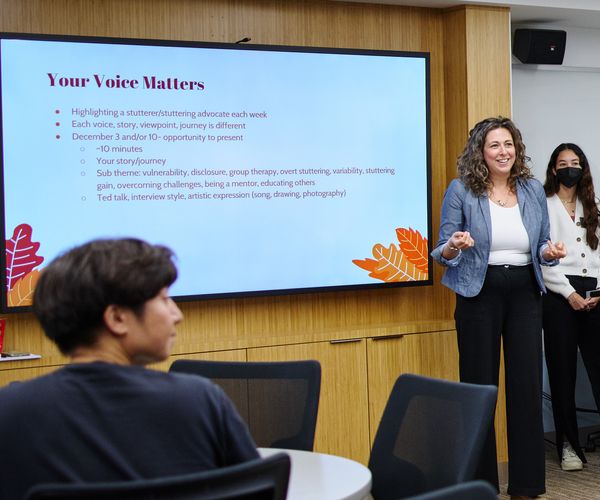A classic speech therapy analogy explains the neurological and psychological connection at play in a speech disorder: the stuttering iceberg.
“The tip is what other people see about you—the blocks, repetitions, or prolon- gations—and below the water is the emotional experience,” says Caroline Brinkert, director of the Center for Stut- tering Therapy and a lecturer in speech, language, and hearing sciences. “So that could be feelings of guilt or shame, embarrassment, avoidance, or anxiety.”
The hidden emotional effects of the disorder can be hard on any stuttering person, but Brinkert says that they’re especially difficult for teenagers, who are more likely to be bullied and experience anxiety than their nonstuttering peers. The risk for social alienation is high.
That’s why, in 2024, Brinkert formed a therapy group for teens. “This group was the byproduct of…hearing so many different individual voices say things like, ‘There’s no one else in my school who stutters,’” she says. “There was so clearly this necessity to get these teens together to share their life experiences, feel less isolated, and learn from each other.”
The center has run an adult stuttering therapy group for more than 30 years, which Brinkert is using as a model. Teens will touch upon strategies and skills to reduce the physical tension of stuttering—which ad- dresses the tip of the stuttering iceberg—but will also focus on tackling the challenges beneath the surface.
“We talk about rebalancing the priorities of therapy: leaning more into discussions like, what might you be avoiding in terms of words or situations, career choices, or college majors, based on either self-stigma or perceived stigma?” she says.
“The real emphasis is on the content of the message and not the surface-level features of how it’s being delivered.”
The group is still in its pilot phase after launching during the fall 2024 semester with up to five teens joining sessions via Zoom or in person. By spring 2025, the group had six new members and had welcomed back two who’d returned. Half of the semester’s six hourlong sessions are devoted to relevant discussion topics—like coping with anxiety, presenting in front of groups, and building confidence in peer
conversations—while the other half serve as open-ended social conversations and are held in partnership with the National Stut- tering Association’s Boston chapter. As word gets out and the group’s numbers continue to grow, Brinkert believes that participants should be in charge of shaping its future direction. A new advisory board of veteran members helps Brinkert shape the group’s long-term goals.
“Teens are in the middle of forming their identities and their value systems,” she says. “They’re so ripe for this conversation, and it’s really exciting to work with them to reframe [their condition], give them tools to feel confident about their communication, knowing that that’s all possible while stuttering.”
STORY BY SOPHIE YARIN
